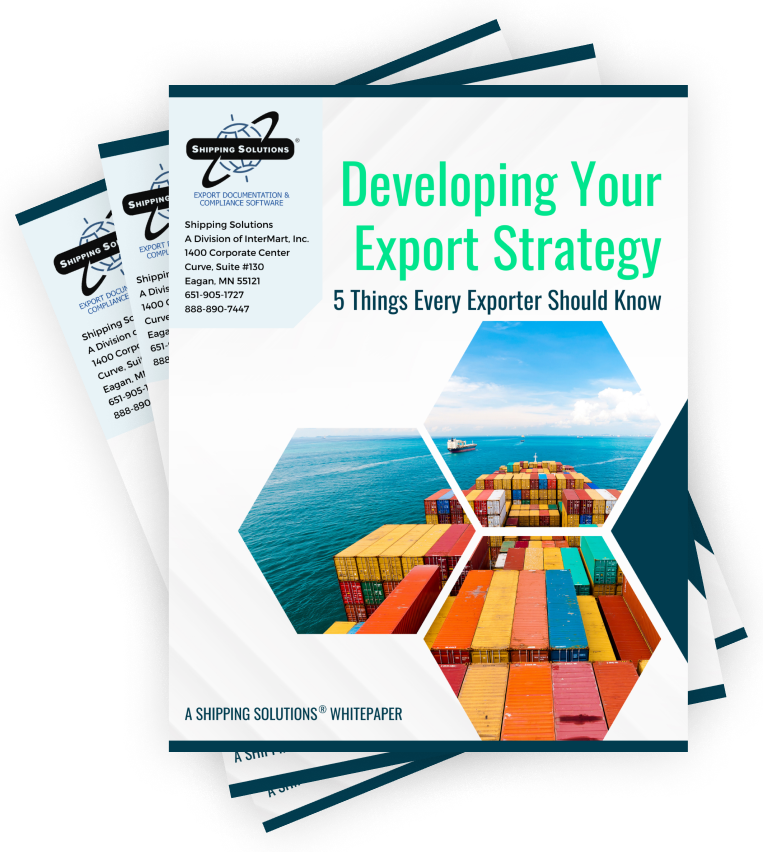The International Trade Blog International Sales & Marketing
How to Set Up Your Company's International Distribution
On: November 11, 2016 | By:  Prema Nakra |
6 min. read
Prema Nakra |
6 min. read
 Once you've zeroed in on new markets for your company's products, you must determine how you will sell and distribute your goods and services in those countries. Fortunately, we live in a global village where technological innovations have made the life of exporters easier by providing multiple ready-to-use global distribution options.
Once you've zeroed in on new markets for your company's products, you must determine how you will sell and distribute your goods and services in those countries. Fortunately, we live in a global village where technological innovations have made the life of exporters easier by providing multiple ready-to-use global distribution options.
Global logistics options include service providers such as freight forwarders, air express outfits, ocean carriers, and overland transportation companies. These entities offer extremely reliable and fast service including tracking of shipment and overnight delivery promises.
How to Ship Your Goods
American-based FedEx, DHL, UPS and Airborne freight services offer local pick-ups, transportation of packages to a single transportation point, sorting according to the addresses, and then shipping them out to their destination all in a matter of a day or two, depending on the destination. Some of these companies such as FedEx and DHL also offer warehouse space for rent to global clients at their transshipment points.
Additionally, there are those internet-inspired e-commerce channels that can help you quickly and inexpensively create a storefront on the internet and start sales transactions online almost overnight. So why do you need to worry about distribution?
In the current technology environment and given receptivity to e-commerce, it is quite conceivable to brainstorm on a marketing idea today, develop the storefront on the web tonight, and be open for business tomorrow. But if you fail to factor in the need for effective communication and promotion, the importance of strategically locating the warehouses, developing appropriate inventory management, and order processing, your website might generate plenty of orders without any profit.
Businesses with global dreams often realize that since understanding the target market, the culture, local regulations, and the like are prerequisites to effectively marketing, they seek out the intermediaries who are familiar with overseas markets. There is more to distribution than simply shipping goods to destination or having a glitzy website.
How to Develop Channel Partnerships
In every country and in every market—underdeveloped, emerging or advanced—consumer and organizational products and services eventually go through some form of distribution process. The distribution process involves the physical handling and distribution of products, the passage of ownership or title to the goods, and buyer and seller negotiation between the manufacturer and intermediaries and between intermediaries and customers.
Your marketing objectives should include reaching the targeted segments with the desired product positioning and return on investment. To achieve these strategic objectives you must plan for more than simply identifying the shipping, airfreight carrier, or ocean carriers. You must design the channel strategy by:
- Laying out the functions that a channel network must perform,
- Identifying the channel intermediaries that will help in performing those functions,
- Negotiating terms and conditions for partnership, and
- Maintaining open communications with channel partners for the mutual benefit of both parties.
Develop policies to assist the channel partners in inventory control and management, merchandising, and local advertising. In addition, offer special pricing and other incentives to help build good relationships. Consider these factors when selecting a channel partner:
- Overall channel costs, which include initial costs of locating and negotiating with the channel partners, as well as the costs of maintaining relationships and controlling channel operations. In addition, logistical costs involving transportation, warehousing and storage, order processing, and servicing the customers/clients should be compared and evaluated.
- Capital requirements for different channel partners may vary based on the scope of their operations and their managerial capabilities. Capital costs typically include the costs of inventories, the cost of goods in transit, costs of accounts receivables, and inventories on consignment.
- As an international marketer you must take into consideration the degree of control desired while expanding internationally. For example, if your firm wishes to maintain strong control over its marketing mix, it might elect to set up a sales subsidiary to work with retail outlets available in the country markets you target. In this event you must take direct responsibility of warehousing and storage, order processing, local transportation, and development and maintenance of relationships with the intermediaries at retail level.
- While selecting your channel partners, due diligence is critically important to determine the distributor or broker’s market coverage including location of their offices, channel member’s home base, and historical (three to five years) sales contribution by geographic locations. Also important to understand is the level of commitment by the channel intermediary to the product and the market, their financial strength, marketing skills, their image and reputation. And seek market knowledge commensurate with the complexities of the selling process.
- International marketers must also seek channel partners complementary in skills, scope of geographic coverage, product lines currently carried, annual sales volume, managerial abilities, financial stability, reputation, strong relationships with participants in the supply chain, and local government agencies.
Piggybacking and Other Distribution and Marketing Tips
In the event your company does not find a channel partner with sufficient interest in your products, piggybacking may be the solution. Piggybacking is an arrangement with a competitor to market your product through its established distribution channels. This arrangement is commonly used when the products offered for distribution to an established company are complementary rather than competitive offerings.
If you employ a direct distribution strategy using digital marketing, pay attention to the following four points:
- Your web pages should be modified to be culturally sensitive in content and looks.
- You must create virtual offices for country markets by buying server space and create mirror sites with voice mail and fax contact points in key markets. Customers in your host country are more likely to visit sites in their own country and in the local language.
- Once your online store—and brand—is open you must consistently promote its existence through organic search engine optimization (SEO), Google pay-per-click advertising, landing pages, product placement, and sponsorships.
- Even though you could use FedEx, UPS and other private delivery services with worldwide delivery capabilities, these may not provide a long-term solution to storage, warehousing and the service related needs of the markets. It may be necessary to set up warehouses near your key markets to speed product delivery. These warehouses can also provide warranty servicing, spare parts, and merchandise returns. Distribution centers may be constructed or leased in the country markets you plan to target. Alternatively, outside vendors (outsourced service providers) may be used to handle the fulfillment tasks including warehousing, inventory management, and order processing.
How to Find Potential Channel Partners
Some of the sources for locating distributors, channel partners or providers of outsourcing services in country markets include the Export Assistance Centers that are part of the U.S. Commercial Service offices, the foreign branch of banks you do business with, specialized directories of distributors, businesses exhibiting at the industry specific international trade shows, industry associations, and embassies and foreign consulates. More specifically the National Association of Export Companies (NEXCO) can assist in your efforts to find export intermediaries.
The U.S. Department of Commerce's Export Trading Company Affairs (ETCA) office can also provide information on locating export trading companies and export management companies in the U.S.
Final Words
In the final analysis, how you set up your international distribution within a specific country market will depend on the nature of your product, the service requirements of your target customers, market size and scope, intensity of competition, your firm’s market position, and the availability of capable and knowledgeable distribution intermediaries.
A successful program will benefit both the exporter and the distributor and include a high level of commitment by both parties to the product and the market, financial strength, marketing skills and market knowledge commensurate with the complexities of selling process, reputation of each partner in their respective communities, and the willingness on part of both to develop an ethical relationship via open and honest communications.
This article was first published in November 2005 and has been updated to include current information, links and formatting.

About the Author: Prema Nakra
Prema Nakra, Ph.D. is an educator, economist and a marketing consultant. Dr. Nakra is a professor of marketingand International Business and MBA Program Director at the School of Management, Marist College. Her academic qualifications include a Ph.D. in economics, MA in economics, and MBA in marketing management.
Prior to joining Marist, Dr. Nakra worked for international organizations including the International Cooperative Alliance for South East Asia, Ellington Duval Inc, Worldwide Marketing Group, and the New School for Social Research. An active member of American Marketing Association, American Economic Association, and Balanced Scorecard Technology Council, she is frequently invited to presents papers and at international business conferences.


